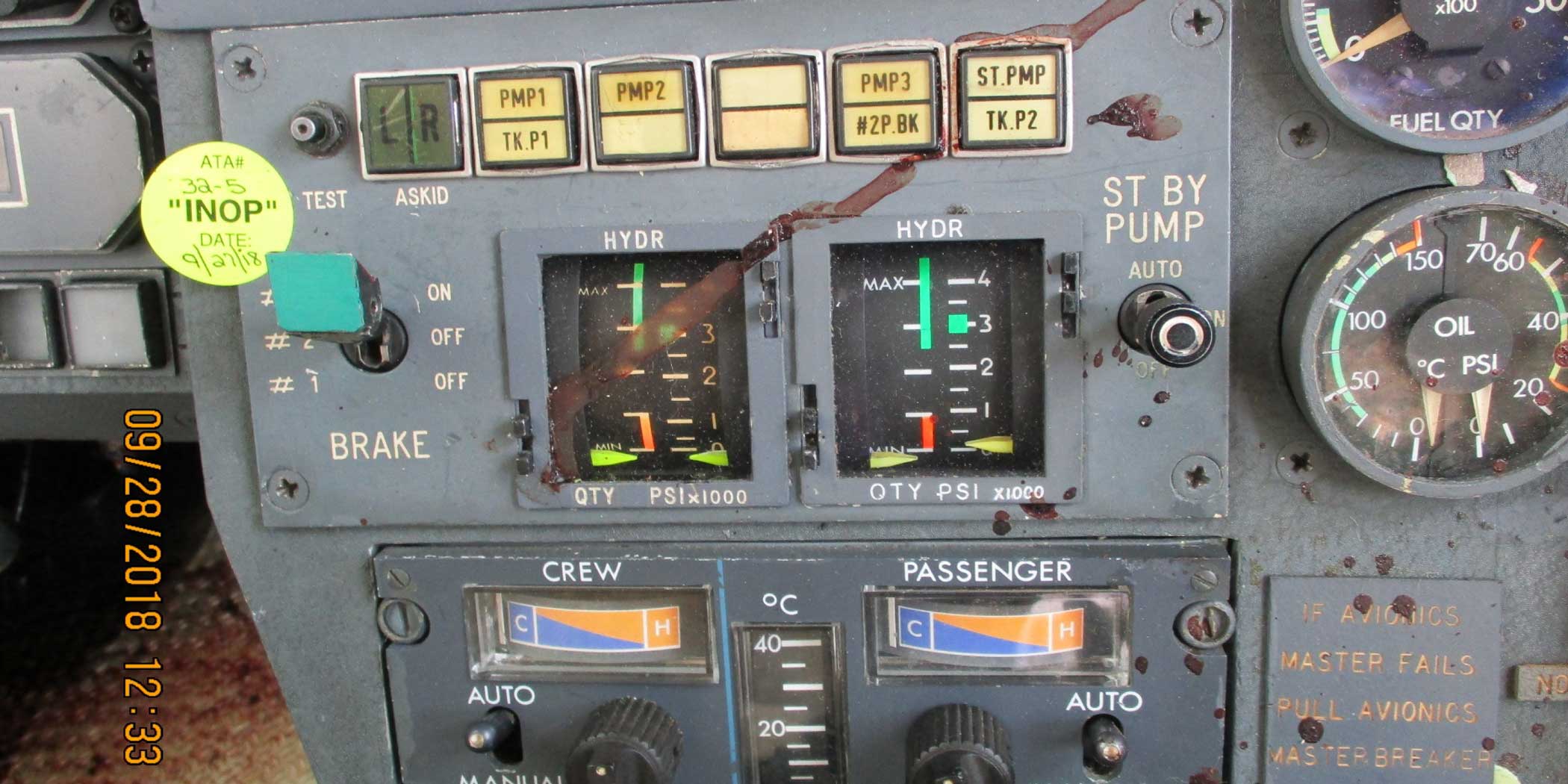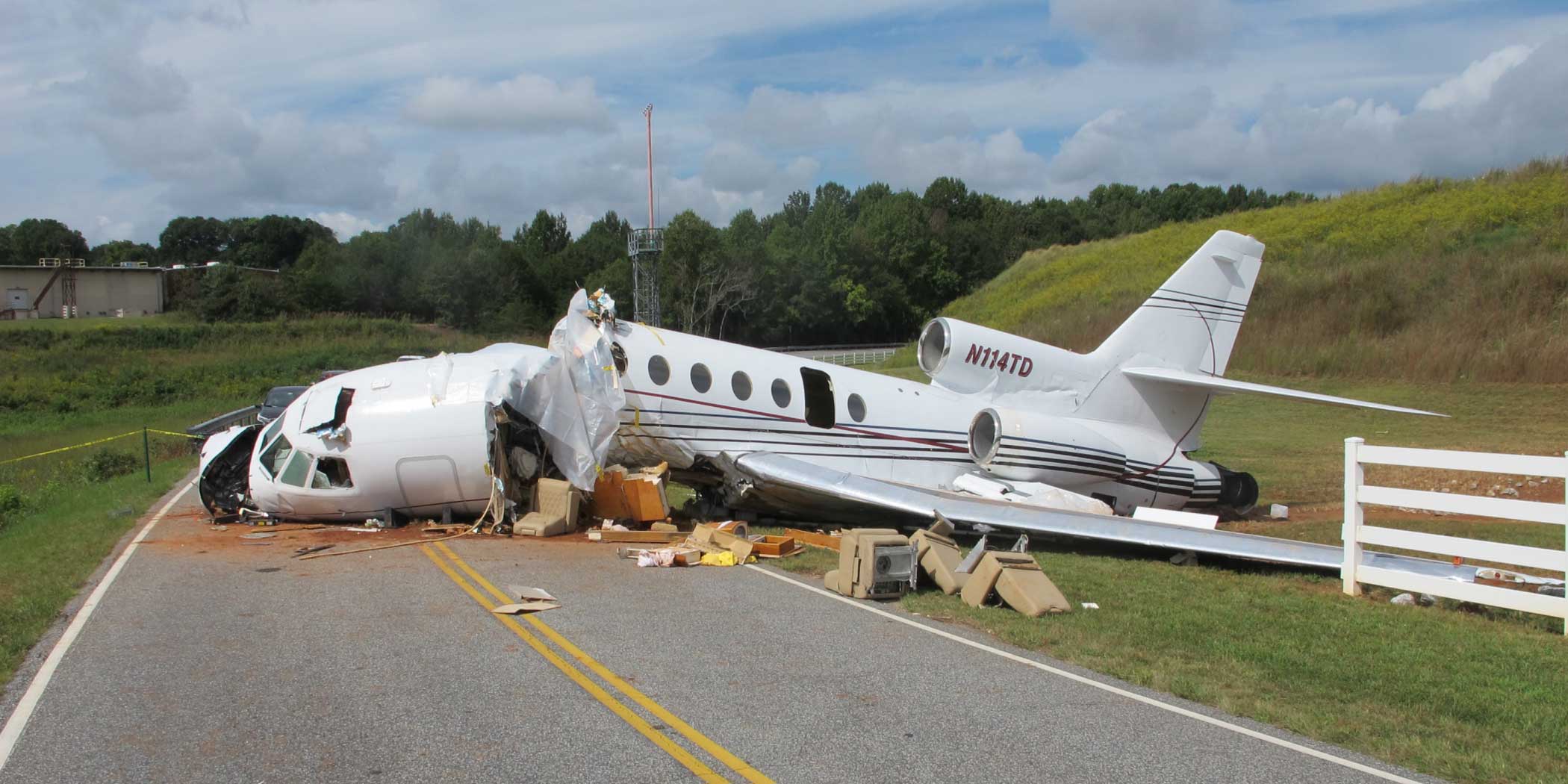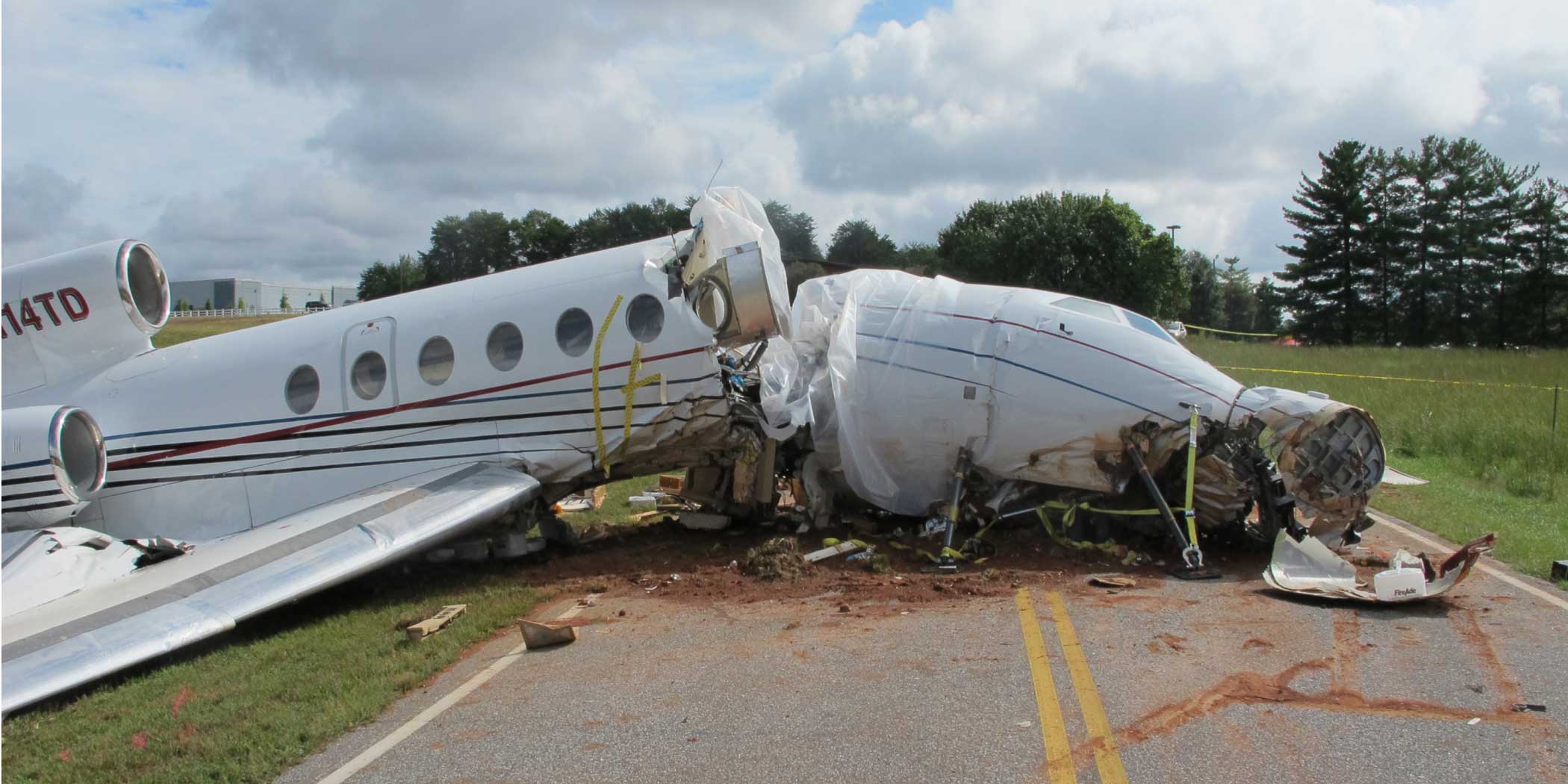On Sept. 27, 2018, a Falcon 50 overran a runway at Greenville, South Carolina. Both pilots died and the two passengers received serious injuries. Air America Flight Services, a Part 135 charter company based at St Petersburg-Clearwater International Airport in Florida, operated the aircraft, N114TD. Company management insisted it was not a revenue flight but invoices presented by the passengers, and the assessment of investigators, proved otherwise. Air America’s owner died in the accident, leaving unanswered questions about the company’s murky history of Part 91 versus Part 135 operations, and the almost total absence of documentation from the FAA has made it difficult to obtain clarity on the issue. The convoluted sequence of events that led to what went wrong during the landing in South Carolina offers proof yet again that an accident’s cause is often far more complex than what occurs in its final moments.
In its investigation, the National Transportation Safety Board (NTSB) determined that discrepancies in N114TD’s anti-skid system likely caused a braking system failure right after touchdown. On the flight deck voice recorder, the pilot-in-command can be heard repeating in rapid succession, “whoa, whoa, whoa,” and “where are the brakes,” “I have no brakes,” “no brakes,” and “get on the brakes,” until the aircraft went over an embankment and then stopped on the airport perimeter road. Photographs of the Falcon 50, its fuselage broken in half, circulated widely on the internet.
As the investigation expanded, the NTSB learned that the anti-skid system discrepancies were known prior to the accident by multiple people associated with the company, including its owner, Steve Fox, who served as the copilot on the Greenville charter. Investigators further found that neither Fox nor the other pilot, John Caswell, was rated to fly as pilot-in-command of the aircraft. Specifically, Fox held no type ratings nor did he even have an instrument rating. Finally, the aircraft, N114TD, was not airworthy and had not been released from maintenance for any flight.
In separate interviews weeks and months later, the company’s director of operations (DO), Joe Vigil, as well as chief pilot Charles Presley and director of maintenance (DM) Tim Fox (Steve's son), would all insist they did not know the flight was being conducted. They claimed to have no knowledge that the aircraft, or indeed the company, was involved in FAR Part 135 charter operations. John Caswell, whose name they learned after the crash, was a complete mystery. “Nobody knew who this man was,” asserted Vigil. Tim Fox and Vigil, both of whom were at work when the aircraft departed, declared they did not even know N114TD had taken off until hours after the fact. Vigil said he found out the airplane was gone only when the company’s FAA principal operations inspector called to tell him it had crashed.

The Falcon 50 had been in storage for about four years, receiving only occasional engine run-ups, until June 22, 2018, when a work order was opened to track its extensive maintenance issues in an effort to return it to service. At the time of the accident, there were several incomplete inspections, airworthiness directives yet to be addressed, and over 100 open discrepancies. Maintenance records also showed that the landing gear was last overhauled in July 2002; it was four years past due when the crash occurred.
Steve Fox and another pilot, Luis Hernandez, flew the Falcon 50 on four “maintenance flights” in the month prior to the accident. Hernandez later told investigators that during those flights, one of which went to Cleveland with a passenger, he found that with the brake system switch in the “#1-ON” position, braking was normal at speeds up to about 15 to 20 knots. Over that speed, the brakes would function only with the system in the “#2-OFF" or "#1-OFF" position and even then without anti-skid protection. Hernandez, who was qualified to serve as pilot-in-command in the aircraft, conveyed this information to Tim Fox and told the NTSB after the accident that Steve Fox was aware of both the problem and remedy. No discrepancies were recorded by either of them in the aircraft logs, however.
In a conversation with the company’s FAA principal maintenance inspector two weeks after the accident, Tim Fox acknowledged that his father had relayed the braking issue to him but added that he also told him the “brakes were fine.” He told the inspector he did not perform any troubleshooting or maintenance on the aircraft’s braking system after the conversation. In an interview with the FAA seven months later, as part of an investigative inquiry, he said he could not recall speaking to Hernandez about any issues with the aircraft. At that time, he said he did not know anything about the four Falcon 50 “maintenance flights” until after they occurred. As to why his father took the aircraft out for those flights, Tim Fox had no idea. Separately, he told the NTSB that as his father owned the aircraft, he had little control over it. This situation, he said, had created “some tension” between them.
According to the NTSB’s final report, at the time of the accident, a placard placed near the braking switch stated: “ATA #32-5 ‘INOP’ DATE: 9/27/18” (ATA code 32-5 involves the anti-skid system). The NTSB assumed it was “likely” placed there by maintenance personnel. Regardless of its source, investigators found that the item was not on the aircraft’s Minimum Equipment List which, according to the DM, had not been used “in a long time.”

In its investigation, the NTSB focused primarily on the braking discrepancy, devoting 180 pages of the 239-page report to that issue. (An additional 33 pages comprised the flight deck voice recorder transcription.) In its probable-cause finding, the board cited the operator for flying an aircraft with “known, unresolved maintenance discrepancies” and the flight crew for its “failure to properly configure the airplane in a way that would have allowed the emergency or parking brake system to stop the airplane during landing.” But to solve the puzzle as to why the conditions existed that permitted this accident to happen requires going beyond the report to information available in the multiple lawsuits spurred by the crash and the FAA’s investigative inquiry. Thousands of pages of depositions and exhibits can be found in these documents, which highlight the complicated relationship Steve Fox had with his employees, and the fealty they offered to the man who dominated every aspect of the company.
Air America’s corporate offices were in West Palm Beach, placing it under the purview of the FAA’s South Florida Flight Standards District Office (FSDO), but the aircraft and operations were based in Clearwater, about 200 miles away on the state’s opposite coast. According to the company principals, the West Palm Beach office existed only for in-person visits with the South Florida FSDO; the DM had never even been to the office. (He also told the NTSB that the principal maintenance inspector had never been out to see the aircraft or his facilities in Clearwater. The principal avionics inspector, he added, had been there once.)
Joe Vigil was hired as DO for Air America in 2013 and said his initial agreement with Steve Fox called for him to fix Fox's "manuals for him and make sure he was in compliance with the FAA.” By Vigil’s recollection, this took about two years, and in that time, because the company lacked “certified pilots,” only Part 91 flights were conducted. Vigil communicated with the South Florida FSDO, submitting updates for the manuals and obtaining approvals. In 2015, he moved from that focus into pilot hiring, but the company continued to operate only under Part 91 as the prospective pilots “never got to the full certification process.” Throughout his tenure, Vigil explained in a deposition, the Part 135 operation was current and active, but the company conducted only Part 91 flights. When directly asked whether Air America ever conducted a Part 135 flight, he said he could not remember any. A former chief pilot was the only pilot he could recall as “identified on the certificate” who “might have” flown Part 135. He left Air America at some point, however, and was replaced, perhaps two years before the accident, according to Vigil, by Charles Presley.
Presley’s recollection of working for the company was quite different. He was actually first hired as chief pilot, according to his deposition, in “about 2010” after answering an ad on the climbto350 website. At that time he also served as Air America’s sole pilot. After about a year, during which he said he conducted multiple flights under Part 135 in the company’s King Air, he left Air America and then did not hear from Steve Fox again until early 2018. Fox told him the Part 135 had fallen out of use and asked, “Would I help him maintain it so he can start using it again?” Presley agreed and was approved as chief pilot and took an FAA checkride so he could serve again as line pilot in the King Air. By his estimation, he was hired the second time only “six to 10 months” before the Falcon 50 crash. He did agree with Vigil on one point, however: Presley also said Air America conducted no Part 135 flights in 2018. As for Tim Fox, the DM, he claimed he had no idea what kind of flights the company was operating.
The question of Part 135 versus Part 91 is critical not only to the accident but to analyzing Air America’s operations and because it raises reasonable concerns about FAA oversight. The NTSB has focused on Part 135 safety in recent years, including it in its annual Most Wanted Lists, but the agency neglected to interview Air America’s management, or the FAA inspectors assigned to the company, in its investigation. In fact, investigators never addressed the potentially illegal nature of the flight’s operation, leaving the passengers to pursue that issue on their own.
From the beginning, the company’s surviving management has been in direct conflict with the passengers on the accident flight. Communicating through their lawyers, passengers Steve Rose and Marci Wilhelm provided copies of 12 invoices, all dated prior to the accident in 2018. The invoices detail specific flights and include taxes and segment and landing fees. All of them, with the exception of the accident flight, are stamped “PAID” and they are all on the letterhead of Clearwater Aviation. According to the passengers, Travis Fox (Tim's brother) provided the invoices.
Steve Fox owned Clearwater Aviation, Inc., a Part 141 flight school also located at St Petersburg-Clearwater International Airport. N114TD and the other aircraft on the Air America Part 135 certificate, a King Air 200 and a Piper Navajo, were based at the Clearwater Aviation facilities and maintained by the flight school. Tim Fox was director of maintenance for the school and Travis was the administrator, according to his remarks to the FAA investigative inquiry. (He described his duties as serving as manager of the school.) All three of the Fox family members were also corporate officers for Clearwater Aviation and its parent company.
Travis Fox professed to have no knowledge of the difference between Part 91 and Part 135 when answering questions in the FAA inquiry, nor did he admit to any knowledge of the billing of the accident flight, the existence of Clearwater Aviation invoices for multiple charter flights, or the depositing of the more than $100,000 in charges that were billed to the N114TD passengers over their series of flights. (He did admit to discovering after the accident a climbto350 application for John Caswell in his father’s office, which likely explained how Caswell came to be hired.) Clearwater Aviation’s position as an apparent broker for Air America, and the incestuous business relationship between the two companies, was never examined in his deposition or in any interview with Vigil, Presley, or Tim Fox.
In an attempt to better understand the FAA’s oversight of Air America’s operations, it was necessary to submit a series of Freedom of Information Act (FOIA) requests to the agency. These requests sought correspondence pertaining to flight training, the Falcon 50’s maintenance, any existing safety concerns, status of the Part 135 certificate, inspectors assigned to oversight, and transcripts from the FAA investigative inquiry with Tim Fox, Joe Vigil, and Travis Fox. (The transcripts for Tim and Travis Fox were subsequently obtained via court exhibits.) To date, only a single response to one request has been provided. In a letter received in mid-July 2021, the FAA stated that the South Florida FSDO had “no responsive documents” to the author's request for the Certificate Management Team history for Air America. When that response was appealed with the names of the company’s principal operations and maintenance inspectors at the time of the accident provided (as found in court documents), the FOIA coordinator professed confusion and promised to follow up with the FSDO and provide clarification. To date, no further response from the FAA, for this FOIA request or any other, has been received. Thus the extent of the FAA’s oversight of Air America—and whether the agency ever raised a single concern about the company—remains a mystery.
The Safe Charter Operations program website (www.faa.gov/about/initiatives/safe_charter_operations/) is the FAA’s formal response to the ongoing problem of illegal Part 135 operations. The website includes a declaration of the problem; a list of recent enforcement actions against various companies, ranging from fines to certificate revocations; and materials for passengers to guide them in determining whether a company is operating legally. Industry trade group National Air Transportation Association has also tackled this issue and formed “an initiative to combat illegal air charter” with a resources website and an illegal charter hotline at www.avoidillegalcharter.com. A quick review makes clear that none of this information would have helped the passengers of N114TD, however. Air America Flight Services had an operating certificate, management appeared competent and responsive, and required federal taxes were charged.
The passengers on the accident flight, Steve Rose and Marci Wilhelm, had no way of knowing that the Falcon 50 was not airworthy when they boarded the aircraft. They could not have known that FAA inspectors had not visited the base in years or that Air America’s longtime billing practices involving Clearwater Aviation were suspect. They placed their trust in Steve Fox, Travis Fox, Tim Fox, Joe Vigil, and Charles Presley to do their jobs, and they trusted the system of FAA oversight and enforcement to protect them from all the things that were beyond their knowledge. Less than a year after the accident, in July 2019, Rose and Wilhelm provided written statements to the court detailing just how significantly the failure of that system has impacted their lives. Rose detailed his injuries as a facial fracture, persistent blurred vision in one eye, and incessant lower back pain. Wilhelm suffered breaks in several places to her left ankle, left tibia, and left femur. Her right tibia was also broken several times. She had a fracture to her L5/6 vertebrae. Her life, she wrote, was spent in near-constant pain and she had required hospitalization and treatment for “depression, anxiety, and PTSD.”
For their part, in April 2019, Joe Vigil and Doug Paton, the personal representative for the estate of Steve Fox, founded Clear Skies Charters, Inc., with an intent to operate charters with the King Air 200. Tim and Travis Fox were also to be involved in the company and a Part 135 certification process was initiated with the Orlando FSDO later that year. According to Vigil, in his deposition, this became delayed due to the pandemic. In response to a recent query, the FAA press office stated that as of September 2021, Clear Skies Charters did not have a Part 135 certificate. It provided no further details as to whether the process was terminated or still ongoing.
Clearwater Aviation continues to operate its flight school at the St Petersburg-Clearwater Airport where its website offers pilot training at “the highest levels of professionalism and safety.” There is no evidence that any investigation has been initiated into the school or its management for involvement in the billing of illegal charters. In their depositions, both Tim Fox and Vigil said they had experienced no enforcement action from the FAA. As for Air America’s chief pilot, Presley told Wilhelm and Rose’s lawyers that no one from the agency had ever even bothered to question him about the accident.